May 5, 2013
by Carole Zangari -
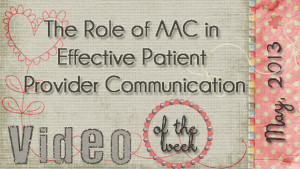
If you’re in a healthcare setting, you probably have noticed the increased attention to communication issues between healthcare providers and individuals who are ‘communication vulnerable.’ As all of us well know, people with AAC needs are certainly in that category. Many of us have worked with AAC clients who’ve had negative experiences communicating with healthcare providers in emergency situations, hospital visits, medical procedures, and just routine preventative care. Our featured video this week is on The Role of AAC in Effective Patient Provider Communication by John Costello, Director of the Augmentative Communication Program at Boston Children’s Hospital. The presentation is part of a larger series organized by Patient Provider Communication network and Sarah Blackstone.
Filed under: Video of the Week
Tagged With: healthcare, hospital, John Costello, patient provider communication
April 28, 2013
by Carole Zangari -
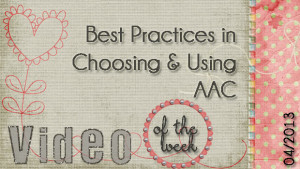
What better way to wrap up a busy month of Autism Awareness and Acceptance than by thinking about best practices? We’re please to be able to share a presentation from the 2012 Summer Institute on Neurodevelopmental Disorders at University of California at Davis MIND Institute. Enjoy “Best Practices in Choosing and Using AAC” by Kristen Carroll and Bonnie Mintun.
Filed under: Video of the Week
Tagged With: ASD, best practice, Bonnie Mintun, EBP, Kristen Carroll, MIND Institute
April 21, 2013
by Robin Parker -

We are loving all of the programs that WORK! We love the use of low & high tech supports that facilitate independence. What do you love?
Filed under: Video of the Week
Tagged With: ASD, iPad, transition, visual supports, work
April 14, 2013
by Robin Parker -
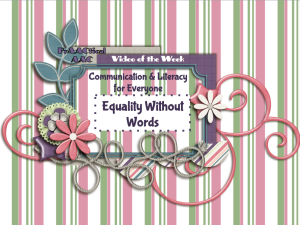
Communication & Literacy for Everyone! Strategies for empowerment. AAC facilitates speech and language development; therefore we need to teach more than nouns.
Filed under: Video of the Week
Tagged With: communication, literacy
April 7, 2013
by Carole Zangari -
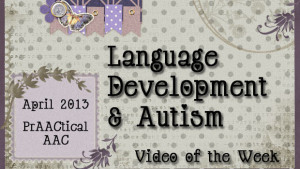
There is no better time than Autism Awareness Month to reflect on the communication services that we provide to children and adults with ASD. Today’s post features Dr. Rhea Paul, Director of the Communication Disorders Section at the Yale Child Study Center. In this recorded presentation, Dr. Paul provides a thorough overview of communication development in people with autism.
Filed under: Video of the Week
March 31, 2013
by Robin Parker -
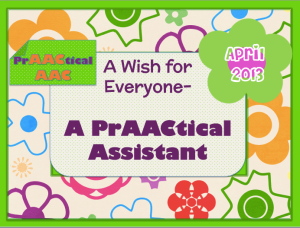
This will definitely make you wish everyone had a Mike! Watch this to smile, feel good and to be inspired.
Filed under: Video of the Week
Tagged With: ASD, assistants, employment, microbusiness
March 24, 2013
by Carole Zangari -
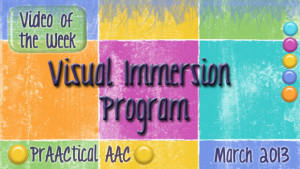
In this week’s featured video, we go to the AAC-RERC to get an in-depth look at a systematic approach to visual supports for people with ASD. Howard Shane and Meghan O’Brien explain the basic premise of the Visual Immersion Program’s approach, the communicative functions it is designed to support, and the key principles and procedures. The webcast is broken into three parts, with accompanying slides and transcripts.
Filed under: Video of the Week
Tagged With: ASD, Howard Shane, Meghan O'Brien, VIP, Visual Immersion Program, visual support
March 17, 2013
by Carole Zangari -
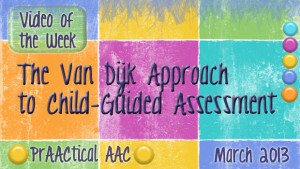
Getting good assessment information on learners with multiple disabilities, hearing, and vision loss is difficult, to say the least. Today we travel to the Netherlands to learn from Dr. Jan Van Dijk, who has pioneered an approach to working with individuals who have deafblindness. This series of webcasts, produced by Perkins School, discusses the theoretical underpinnings and practical aspects of the Van Dijk approach to child-guided assessment.
Filed under: Video of the Week
Tagged With: assessment, deafblind, hearing loss, multiple disabilities, Van Dijk, vision loss
March 3, 2013
by Carole Zangari -

Video modeling is an empirically supported intervention strategy hat more of us could be using in our clinical work. This week we feature some examples of video modeling for some common communication behaviors. We love the fact that these focus on adults. Kudos to the team at Villa Esperanza Speech and Language Center for making and sharing these videos. Asking for a Break Saying Goodbye
Filed under: Video of the Week
February 24, 2013
by Carole Zangari -

We’re always looking for great materials to share with colleagues and parents about topics related to AAC. This video by OCALI (the Ohio Center for Autism and Low Incidence) has been one of our favorites. It gives a brief overview of why visual supports are so important in the educational and clinical services provided to individual with ASD and other developmental disabilities.
Filed under: Video of the Week
Tagged With: ASD, clinical rationale, visual supports









